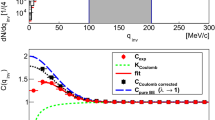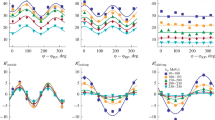Abstract
We present results on interferometry correlations for pions emitted in central p+Pb collisions at \(\sqrt{s_{NN}}=5.02~\hbox {TeV}\) in a \(3+1\)-dimensional viscous hydrodynamic model with initial conditions from the Glauber Monte Carlo model. The correlation function is calculated as a function of the pion pair rapidity. The extracted interferometry radii show a weak rapidity dependence, reflecting the lack of boost invariance of the pion distribution. A cross term between the out and long directions is found to be nonzero. The results obtained in the hydrodynamic model are in fair agreement with recent data of the ATLAS Collaboration.
Similar content being viewed by others
Avoid common mistakes on your manuscript.
1 Introduction
In relativistic p+Pb collisions at the CERN Large Hadron Collider (LHC) a small region of large density matter is formed, which makes possible the generation of a collective flow in the expansion [1]. A number of signatures of collectivity due to final state interactions have been observed experimentally in small collision systems at relativistic energies (see e.g. [2]). We use the viscous hydrodynamic model to describe the dynamics in p+Pb interactions. We note that the initial state effect can also explain the observed two-particle correlations [3].
Quantum interferometry correlations for identical particles can serve as a measure of space-time correlations in the source [4, 5]. These interferometry (also named Hanbury Brown–Twiss (HBT)) correlations have been studied in both elementary and nuclear collisions. An estimate of the size of the emission region, in the form of the HBT radii, can be extracted from a fit to the interferometry correlations. HBT radii have been measured in p+Pb collisions [6, 7] and can be reproduced fairly well in hydrodynamic models posing Glauber model or color glass condensate initial conditions [8,9,10].
In collisions of symmetric systems the correlation function in relative momentum of the pair is usually parametrized using three HBT radii [11, 12]. For a source without forward–backward symmetry, e.g. for pairs at forward/backward rapidity, an additional cross term can appear in the correlations function [13]. Such a term is predicted to be significant in the case of asymmetric collisions, d+Au or p+Pb [14].
Recently the ATLAS Collaboration has presented results on the interferometry correlations in p+Pb collisions for different rapidities of the pion pair [15]. The HBT radii show a rapidity dependence. The size of the emission region is larger on the Pb going side. The cross term is also found to be nonzero, reflecting the rapidity dependence of the charged particle density.
In this paper we present results for the interferometry radii in p+Pb collisions with 0–1\(\%\) centrality calculated in a wide range of rapidities corresponding to the pioneering measurements of the ATLAS Collaboration. As in the experiment, an exponential ansatz is used that better reproduces the simulated correlation function. We show that the hydrodynamic model with Glauber model initial conditions can semi-quantitatively reproduce the experimental observations. For the first time, the presented model calculations allow one to compare quantitatively the predicted magnitude of the new cross term in the correlation function with experiment. Good agreement is found. It means that the space-momentum correlations built in during the hydrodynamic expansion, including the predicted forward–backward asymmetry, are consistent with experiment.
2 Hydrodynamic model and HBT correlations
We describe the evolution of the matter created in p+Pb collisions using the viscous hydrodynamic model, with initial entropy density given by the nucleon Glauber Monte Carlo model. The details and the parameters of the model can be found in [8]. The model describes well the spectra and the azimuthal flow coefficients. At the end of the hydrodynamic evolution pions are emitted from the freeze-out hypersurface. In the paper we use the rapidity in the nucleon–nucleon center of mass frame, which is shifted by 0.465 rapidity units from the laboratory frame at the LHC. The Pb is going in the negative rapidity direction. The central rapidity region \(|y|<0.5\) in the LHC laboratory frame corresponds approximately to \(-1<y<0\) in the nucleon–nucleon center of mass frame.
Pairs of same-charge pions emitted at positions \(x_1\) and \(x_2\), with momenta \(\mathbf{p_1}\) and \(\mathbf{p_2}\), are counted. The 3-dimensional correlation function is constructed by binning in relative (\(\mathbf{q}=\mathbf{p_1}-\mathbf{p_2}\)) and average transverse (\(k_T=|\mathbf{p_1}+\mathbf{p_2}|/2\)) momentum of the pair, in the longitudinal comoving system [16]. To increase the statistics for the pion pairs, for each hydrodynamic freeze-out hypersurface 500 realistic events are generated (using a statistical emission procedure [16]) and combined together.
We use a symmetrized plane wave two-pion wave function in the definition of the correlation function. Therefore, no corrections are made for Coulomb interaction in simulated correlation function. The fitted form of the correlation function is
where
with the three components of the relative momentum \(q_{\mathrm{out}}\), \(q_{\mathrm{side}}\), and \(q_{\mathrm{long}}\) [11, 12]. The exponential ansatz (1) is the same as the one used by the ATLAS Collaboration [15], the fitted HBT parameters \(R_{\mathrm{out}}^E\), \(R_{\mathrm{side}}^E\), and \(R_{\mathrm{long}}^E\) and the cross term \(R_{\mathrm{mix}}^E\) are different from the cases of the Gaussian ansatz used in Ref. [14]. To indicate that the parameters in the formula correspond to the exponential ansatz we add a superscript \(R^E\) in the notation. A larger emission region gives larger HBT parameters \(R^E\) in the pion correlation function. Note, however, that when using the exponential ansatz, the value of the fitted parameter cannot be directly interpreted as the size of the effective emission source, although we still use the name HBT radii for the fitted parameters.
Three cross sections of the interferometry correlation function are shown in Fig. 1, obtained in the hydrodynamic model for the pair transverse momentum \(0.2~\hbox {GeV}<k_T<0.3~\hbox {GeV}\) and rapidity \(-1<y_{\pi \pi }<0\). In the general case there is no reflection symmetry \(q_{\mathrm{out}} \leftrightarrow -q_{\mathrm{out}}\) or \(q_{\mathrm{long}} \leftrightarrow -q_{\mathrm{long}}\). Both negative and positive values for the \(\mathbf{q}\) components are taken into account for the fits. The correlation function is calculated for several bins in the average transverse momentum and rapidity of the pair \(y_{\pi \pi }\).
Expanding Eq. (2) one identifies terms corresponding to the three relative momenta q,
Points represent the interferometry correlations for pions in central (0–1%) p+Pb collisions, calculated in the viscous hydrodynamic model; \(C(q_{\mathrm{out}},q_{\mathrm{side}}=0,q_{\mathrm{long}}=0)\) (panel (a)), \(C(q_{\mathrm{out}}=0,q_{\mathrm{side}},q_{\mathrm{long}}=0)\) (panel (b)), and \(C(q_{\mathrm{out}}=0,q_{\mathrm{side}}=0,q_{\mathrm{long}})\) (panel (c)). The solid lines represent the fitted correlation function in the region \(0.025~\hbox {GeV}<|\mathbf{q}|<0.3~\hbox { GeV}\)
Interferometry radii in central p+Pb collisions as a function of average pair momentum \(k_T\). Results of 3-dimensional hydrodynamic calculations are compared to data from the ATLAS Collaboration [15]. \(R_{\mathrm{out}}\), \(R_\mathrm{side}\), \(R_{ long}\), and \(R_\mathrm{mix}\) are shown in a through d
The formula used by the ATLAS Collaboration deviates from the standard Gaussian ansatz in two respects. First, the exponential form is used instead of a Gaussian. It is justified by the fact that in the range of the fit the exponential ansatz works better (compare Fig. 1 from this work and Fig. 1 from [8]). Second, the terms in (3) differ. Notice that the scales multiplying \(q_{\mathrm{long}}^2\) or \(q_{\mathrm{out}}^2\) are \({R_{\mathrm{long}}^E}^2+{R_{\mathrm{mix}}^E}^2\) and \({R_{\mathrm{out}}^E}^2+{R_{\mathrm{mix}}^E}^2\), not \({R_{\mathrm{long}}^E}^2\) and \({R_{\mathrm{out}}^E}^2\). It would be more justified to call \(R_{\mathrm{long}}^E\) the parameter \(\sqrt{{R_{\mathrm{long}}^E}^2+{R_{\mathrm{mix}}^E}^2}\). In practice, the relative difference between the two is less than \(5 \times 10^{-4}\). The situation is different for the off diagonal term \(2 (R_{\mathrm{long}}^E + R_{\mathrm{long}}^E) R_\mathrm{mix }^E q_{\mathrm{out}} q_{\mathrm{long}}\). It would be natural to identify \((R_{\mathrm{long}}^E + R_{\mathrm{long}}^E) R_\mathrm{mix }^E\) with the scale parameter \({R_{ol}^E}^2\). It is very different from the parameter \(R_{\mathrm{mix}}^E\), which is called \(R_\mathrm{ol}\) by the ATLAS Collaboration. To avoid suggesting that \(R_{\mathrm{mix}}^E\) gives the scale of the term \(q_{\mathrm{out}}q_{\mathrm{long}}\) we use the symbol \(R_{\mathrm{mix}}^E\) to denote the cross-term parameter in the metric (2).
Interferometry radii in central p+Pb collisions as a function of average pair rapidity \(y_{\pi \pi }\). Results of 3-dimensional hydrodynamic calculations are compared to data from the ATLAS Collaboration [15]. \(R_\mathrm{out}^E\), \(R_\mathrm{side}^E\), \(R_\mathrm{long}^E\), and \(R_\mathrm{mix}^E\) are shown in (a) through (d)
3 Transverse momentum dependent interferometry correlations
In Fig. 2 are shown the three HBT radii and the cross term \(R_{\mathrm{mix}}^2\) as functions of the average transverse momentum \(k_T\), for \(-1<y_{\pi \pi }<0\). The values of the fitted parameters depend slightly on the fit range for \(\mathbf{q}\). We have varied the range of the relative momentum in the fit \(q_\mathrm{low}<|\mathbf{q}|<0.3~\hbox {GeV}\), \(q_\mathrm{low}\in [0.02,0.03]~\hbox {GeV}\). The vertical size of the boxes in Figs. 2 and 3 represents an estimate of the uncertainty in the fitted parameters obtained by varying the fit range, for the experimental data the vertical size of the boxes represents the experimental error.
The size of the effective emission region decreases with \(k_T\). This indicates the existence of strong correlations between the momentum and the emission point for the emitted particles. Due to the collective flow pion pairs of high transverse momentum are effectively emitted from a smaller region of the source [17]. The model describes well the experimental data for \(R_{\mathrm{out}}^E\), while \(R_{\mathrm{side}}^E\) is slightly underestimated. The pion distribution in rapidity is not flat, which makes the correlations asymmetric in the forward–backward direction. We find a nonzero cross term \(R_{\mathrm{mix}}^E\), the magnitude of this term decrease with \(k_T\) in a similar way as \(R_{\mathrm{out}}^E\) and \(R_{\mathrm{long}}^E\). The asymmetry of the interferometry correlation function can be related to the forward–backward asymmetry of the average emission times of pions from the source (Fig. 4 in [14]). Pions are emitted earlier on the proton going side and the correlation coefficient between the longitudinal position and time becomes nonzero.
4 Rapidity dependent interferometry correlations
In Fig. 3 presents the rapidity dependence of the HBT parameters and the \(R_{\mathrm{mix}}^E\) cross term for pion pairs with \(0.2~\hbox {GeV}<k_T<0.3~\hbox {GeV}\). Both the experimental data and the simulation results show some dependence on the pion pair rapidity \(y_{\pi \pi }\). However, the experimentally observed rapidity dependence is slightly stronger. We notice that the model correctly describes the experimental data for the cross term \(R_{\mathrm{mix}}^E\) (panel (d)) in Fig. 3. Both the magnitude and the sign of the cross term are fairly well reproduced.
The rapidity distribution of pions emitted in central p+Pb collisions is far from boost invariant (Fig. 4). The asymmetry results from the large difference in the number of participants between the two projectiles, one for the proton and 19 on average for the Pb nucleus. The change in the number of emitted pions with rapidity determines the change in the effective size of the emission region. The sign of the cross term \(R_{\mathrm{mix}}^E\) follows approximately the reverse sign of the slope of the rapidity distribution of pions.
5 Summary
We analyze the interferometry correlations for pions emitted in central p+Pb collisions at the LHC. The correlations functions are calculated in the viscous hydrodynamic model with Glauber Monte Carlo initial conditions. The correlation function is constructed from same-charged pion pairs. Three interferometry radii are extracted from an exponential fit to the correlation function. The lack of forward–backward symmetry in the emission region leads to an additional cross-term coupling the \(q_{\mathrm{out}}\) and \(q_{\mathrm{long}}\) directions. The corresponding cross-term parameter \(R_{\mathrm{mix}}^E\) is found to be nonzero.
The interferometry parameters \(R_{\mathrm{out}}^E\), \(R_{\mathrm{side}}^E\), \(R_{\mathrm{long}}^E\), and the cross term \(R_{\mathrm{mix}}\) are calculated as functions of the average transverse momentum \(k_T\) and rapidity \(y_{\pi \pi }\) of the pion pair. The model reproduces the recent ATLAS Collaboration data to 10% accuracy for the \(k_T\) dependence of the HBT parameters. We find that the HBT radii as functions of the pair rapidity \(y_{\pi \pi }\) are smaller on proton going side. The rapidity dependence of the cross term follows the slope of the rapidity distribution of emitted pions and is in good agreement with experimental data. The calculation confirms that the hydrodynamic model can reproduce qualitatively the space-time features of the emission source produced in high energy p+Pb collisions.
References
P. Bożek, Phys. Rev. C 85, 014911 (2012)
C. Loizides, Nucl. Phys. A 956, 200 (2016)
K. Dusling, R. Venugopalan, Phys. Rev. D 87, 094034 (2013)
M.A. Lisa, S. Pratt, R. Soltz, U. Wiedemann, Ann. Rev. Nucl. Part. Sci. 55, 357 (2005)
U.A. Wiedemann, U.W. Heinz, Phys. Rept. 319, 145 (1999)
J. Adam et al., Phys. Rev. C 91, 034906 (2015)
S. Chatrchyan et al., CMS-PAS-HIN-14-013 (2014)
P. Bożek, W. Broniowski, Phys. Lett. B 720, 250 (2013)
P. Romatschke, Eur. Phys. J. C 75, 305 (2015)
H. Mäntysaari, B. Schenke, C. Shen, P. Tribedy, Phys. Lett. B 772, 681 (2017)
G.F. Bertsch, Nucl. Phys. A 498, 173c (1989)
S. Pratt, Phys. Rev. D 33, 1314 (1986)
S. Chapman, P. Scotto, U.W. Heinz, Phys. Rev. Lett. 74, 4400 (1995)
P. Bożek, Phys. Rev. C 90, 064913 (2014)
M. Aaboud et al. arXiv:1704.01621 (2017)
M. Chojnacki, A. Kisiel, W. Florkowski, W. Broniowski, Comput. Phys. Commun. 183, 746 (2012)
S. Akkelin, Y. Sinyukov, Phys. Lett. B 356, 525 (1995)
Acknowledgements
Supported in part by Polish Ministry of Science and Higher Education (MNiSW), by National Science Centre, Grant 2015/17/B/ST2/00101, and by PL-Grid Infrastructure.
Author information
Authors and Affiliations
Corresponding author
Rights and permissions
Open Access This article is distributed under the terms of the Creative Commons Attribution 4.0 International License (http://creativecommons.org/licenses/by/4.0/), which permits unrestricted use, distribution, and reproduction in any medium, provided you give appropriate credit to the original author(s) and the source, provide a link to the Creative Commons license, and indicate if changes were made.
Funded by SCOAP3
About this article
Cite this article
Bożek, P., Bysiak, S. Interferometry correlations in central p+Pb collisions. Eur. Phys. J. C 78, 53 (2018). https://doi.org/10.1140/epjc/s10052-017-5482-5
Received:
Accepted:
Published:
DOI: https://doi.org/10.1140/epjc/s10052-017-5482-5








